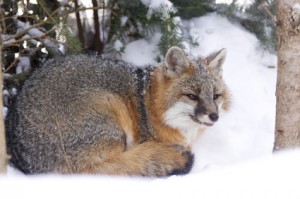Family, Description and Size:
The Gray Fox – Urocyon cinereoargenteus is a mammal and a member of the Carnivora order. It can be easily differentiated by the similar red Fox through the lack of “black stockings and the gray fur on its back. The pupils of the Gray Fox are oval and not slit-like like those of most Vulpes (foxes).
The Gray Fox has a strong neck, grizzled upper parts and a black-tipped, bushy tail. Its size ranges from 30 to 44.3 inches (the tail not included) and it weighs around 3.6 to 7 pounds. Males are usually larger than females, but are very similar in color and shape.
Range and Habits:
The Gray Fox can be found throughout southern North America (including most of the United States), from the southern regions of Canada to the northernmost regions of Venezuela and other South American countries.
The Gray Fox can climb onto trees; a trait shared only the Asian raccoon dog among all canid species. It climbs using its sharp hooked claws and it descends backwards slowly in order to reach the ground. This allows the Gray Fox to avoid predators, as well as to search for food on trees.
The Gray Fox always prefers meat but is an omnivore who also needs fruits and vegetables to survive. It will feed on small rodents, birds and its favorite meal: the cottontail rabbit. Fruit is a very important part of the Gray Fox’s diet. Depending on the region and season it will also consume vegetable matter and other types of small creatures like insects. It hunts always on its own. The Gray Fox is nocturnal or crepuscular, meaning it hunts during the night or during twilight.
General Information:
Gray Foxes are monogamous. A pair will exclusively mate for life, producing an annual litter of 1 to 7 kits. The breeding season depends on the region, with it starting as early as February in some states or as late as March in others. As soon as a kit is 3 months old it will hunt alongside its parents and at 4 months old the kit will have its permanent dentition and will start hunting on its own.
Predators, Mortality and Lifespan:
The predators of the Gray Fox include coyotes, mountain lion, bobcats and other larger carnivores. When the Gray Fox are young they are also in danger from owls and large birds. They can coexist with the red fox and
wherever that is the case the Gray Fox is dominant. However, the red fox have taken up larger territories since they are more adaptable to new habitats than the Gray Fox, and can survive on less food.
Parasites and diseases add to the mortality of the species, as well as car accidents and destruction of habitat. Still, the Gray Fox is on the list of least concern of endangered species and can be hunted by hunters who possess the appropriate hunting license.
The Gray Fox lives for an average of three to four years in the wild.



